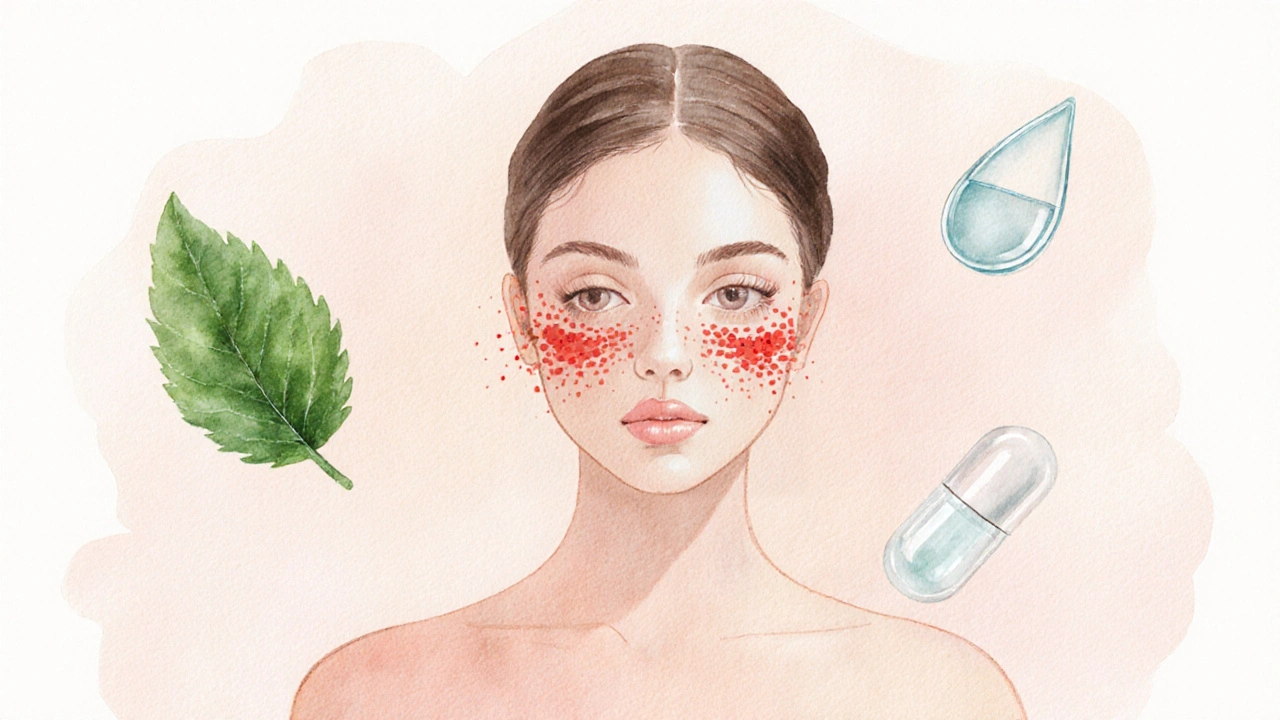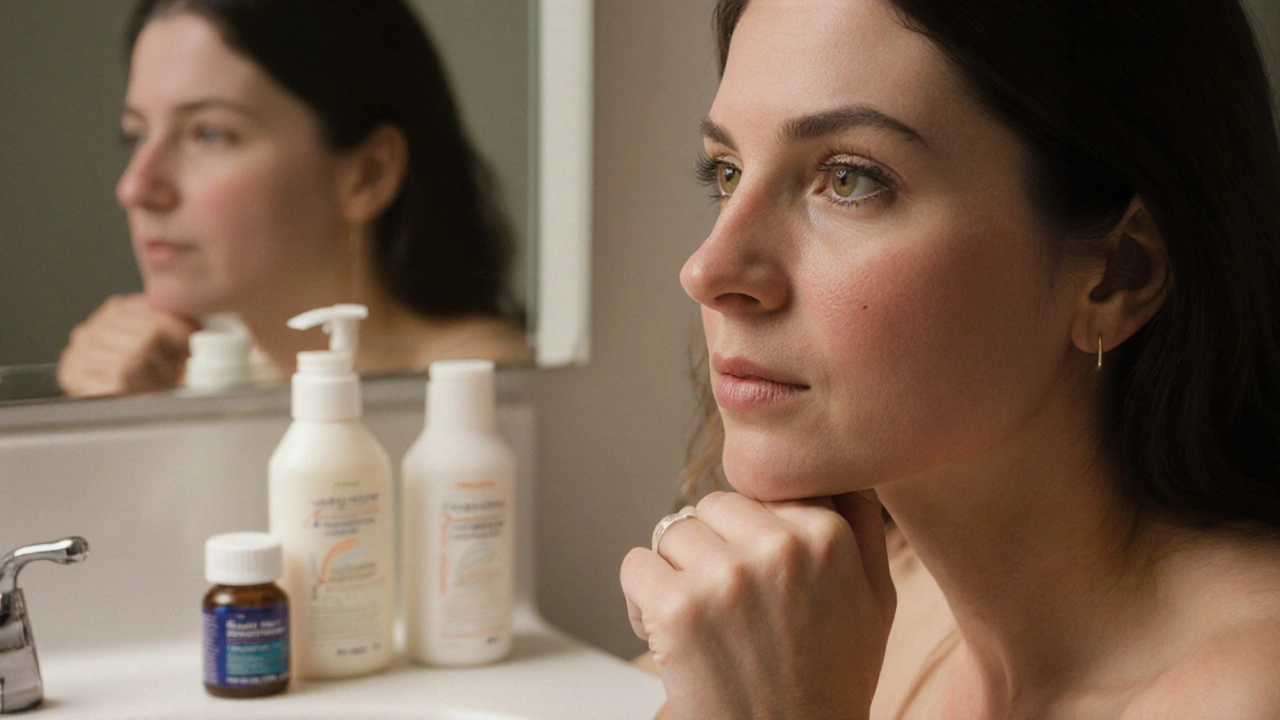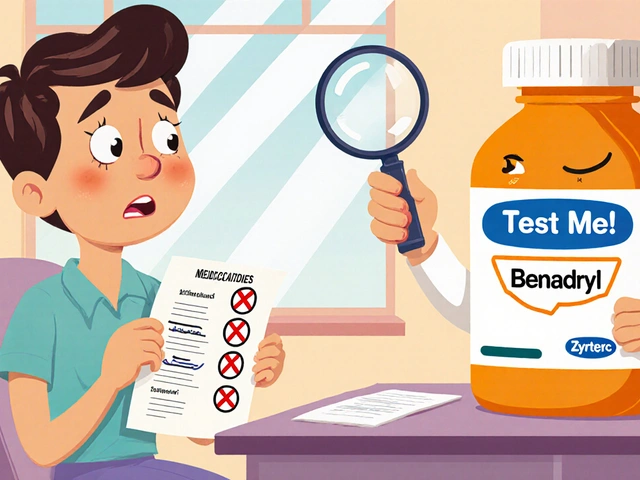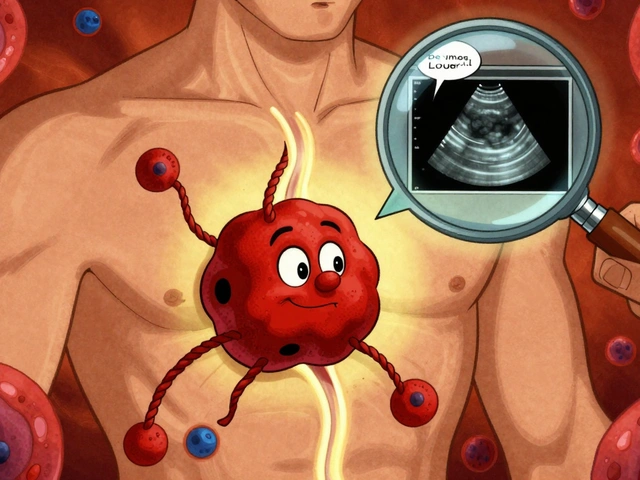Estrogen & Rosacea Quiz
Answer the following questions to see if your skin redness might be hormone-related. This quiz is designed to guide you towards understanding potential links between estrogen deficiency and rosacea-like symptoms.
1. Has your skin redness started after menopause or a significant hormonal change?
2. Do you experience flushing more often in warm environments?
3. Are you experiencing other menopausal symptoms such as night sweats or mood swings?
4. Have you recently switched or stopped hormonal birth control?
5. Do you notice increased redness after drinking hot beverages?
Your Result:
It's recommended to consult with a dermatologist and consider getting a hormone panel to confirm estrogen levels. Early detection can lead to better management strategies.
Ever wondered why your cheeks flare up just when you’re stressed or after a hot shower? It might not just be the weather or your diet - a dip in estrogen deficiency could be lurking beneath the surface, nudging your skin toward rosacea and persistent redness.
Key Takeaways
- Estrogen helps keep blood vessels stable and skin barrier strong; low levels can trigger rosacea‑like flare‑ups.
- Menopause, certain birth‑control changes, and hormonal disorders are common culprits.
- Managing the condition involves skin‑care tweaks, lifestyle shifts, and sometimes hormone‑focused therapy.
- Seeing a dermatologist and getting hormone panels can pinpoint the root cause.
- Targeted nutrition and stress control round out a practical plan.
What Is Estrogen?
Estrogen is a group of hormones primarily produced in the ovaries that regulate reproductive health, bone density, and skin function. Though we often hear about estrogen in the context of fertility, its influence spreads far beyond the uterus. In skin, estrogen promotes collagen synthesis, boosts moisture retention, and keeps tiny blood vessels from over‑reacting to temperature changes.
How Estrogen Keeps Your Skin Calm
Think of estrogen as a traffic controller for your skin’s micro‑circulation. It signals the lining of blood vessels to stay relaxed, reducing the chance of sudden flushing. It also signals keratinocytes - the cells that build the skin barrier - to produce lipids that lock in water. When estrogen drops, those safety nets weaken.
Rosacea 101: The Red‑Skin Disorder
Rosacea is a chronic inflammatory condition characterized by facial redness, visible blood vessels, and sometimes papules or pustules. While the exact cause is still a puzzle, researchers agree that vascular instability, immune system quirks, and a compromised skin barrier are central players.
Connecting the Dots: Low Estrogen → Rosacea‑Like Redness
Multiple studies show that women entering menopause often report new‑onset facial flushing. The link lies in three main mechanisms:
- Vascular dysregulation: Without estrogen’s calming effect, tiny arteries dilate too easily, leading to the classic “blush” of rosacea.
- Inflammatory surge: Estrogen normally curbs pro‑inflammatory cytokines like IL‑6. A dip allows these molecules to rise, amplifying skin inflammation.
- Barrier breakdown: Lower estrogen means less ceramide production, so the skin loses moisture faster and becomes more reactive to irritants.
These changes create a perfect storm for rosacea flare‑ups, especially when combined with triggers like hot drinks, spicy foods, or extreme temperatures.
Who’s Most at Risk?
Anyone whose estrogen levels swing dramatically can face skin redness issues. Common scenarios include:
- Menopause - natural decline of estrogen after age 45‑55.
- Post‑surgical oophorectomy (removal of ovaries).
- Polycystic ovary syndrome (PCOS) - hormonal imbalance that can paradoxically lower estrogen while raising androgens.
- Switching or stopping hormonal birth control.
- Extreme dieting or eating disorders that disrupt hormone production.

Diagnosing the Hormone‑Redness Connection
First step: schedule a visit with a dermatologist who can assess skin symptoms and rule out other conditions like eczema or lupus. If rosacea is confirmed, ask about a hormone panel. Blood tests measuring estradiol, follicle‑stimulating hormone (FSH), and luteinizing hormone (LH) give a snapshot of estrogen status.
Management Strategies
Below is a quick‑look table that lines up three common approaches.
| Approach | How It Works | Pros | Cons | Typical Use |
|---|---|---|---|---|
| Topical Medications | Reduces inflammation and bacterial load (e.g., metronidazole, azelaic acid) | Easy to apply, minimal systemic effect | May cause dryness or irritation | First‑line for mild‑moderate rosacea |
| Hormone Therapy | Restores estrogen levels via transdermal patches or low‑dose oral estradiol | Addresses root cause of vascular instability | Requires monitoring; not suitable for women with certain cancers | Post‑menopausal women with confirmed estrogen deficiency |
| Lifestyle & Skin‑Care Adjustments | Minimizes triggers, strengthens barrier with ceramide‑rich moisturizers | No medication needed; improves overall skin health | Requires consistent effort; results build slowly | All rosacea patients |
Topical and Skincare Tips
- Choose gentle, fragrance‑free cleansers; avoid scrubbing.
- Apply a ceramide‑boosting moisturizer within a minute of washing to lock in moisture.
- Sun protection is non‑negotiable - broad‑spectrum SPF 30+ helps keep blood vessels from over‑reacting.
- Consider green‑tea or niacinamide serums; both have anti‑inflamatory perks.
When Hormone Therapy Makes Sense
If blood work confirms low estradiol (typically below 30pg/mL in post‑menopausal range) and rosacea is a major quality‑of‑life issue, a dermatologist or endocrine specialist may suggest a low‑dose estrogen patch. Transdermal delivery is favored because it bypasses the liver, lowering clotting risk.
Typical regimen: a 0.025mg/day estradiol patch changed twice weekly. Follow‑up labs after 8‑12 weeks ensure levels have risen into the target range (40‑100pg/mL) without excess.
Nutrition and Lifestyle Hacks
Foods rich in phytoestrogens - soy, flaxseeds, lentils - can gently support estrogen pathways. Pair that with a diet high in omega‑3 fatty acids (salmon, walnuts) to dampen inflammation.
Stress spikes cortisol, which can further suppress estrogen. Incorporate short daily practices like breathing exercises, yoga, or a brisk 20‑minute walk.
Quick Self‑Check: Is Your Redness Hormone‑Driven?
- Did the redness start after menopause, a hormonal birth‑control change, or a major weight shift?
- Do you notice flushing in warm environments more than usual?
- Are other menopausal signs present - night sweats, mood swings, dry skin?
If you answered “yes” to two or more, bring it up with your dermatologist. A simple hormone panel could reveal the missing piece.
Next Steps: Building Your Redness‑Reduction Plan
- Book a dermatologist appointment for rosacea confirmation.
- Ask for a hormone panel (estradiol, FSH, LH).
- Start a gentle skin‑care routine focused on barrier repair and sun protection.
- Track triggers in a journal - note foods, temperature changes, stress levels.
- If estrogen is low, discuss transdermal therapy options with a qualified provider.
- Incorporate at least two anti‑inflammatory foods daily and practice a stress‑relief technique.

Frequently Asked Questions
Can low estrogen cause rosacea in men?
Men produce estrogen in smaller amounts, mainly via aromatization of testosterone. In cases of severe hypogonadism or certain medications that block estrogen, a slight increase in facial redness can occur, but it’s far less common than in women. Most male rosacea cases stem from other triggers.
Is it safe to use over‑the‑counter estrogen creams for skin redness?
OTC creams often contain phyto‑estrogen extracts that are weak and poorly regulated. They might help mildly, but they lack the dosage consistency of prescription therapy. Always talk to a healthcare professional before self‑prescribing hormonal products.
Do hot beverages worsen rosacea linked to estrogen loss?
Hot drinks raise core body temperature, prompting vasodilation. If estrogen’s stabilizing effect is low, the vessels stay dilated longer, intensifying redness. Switching to lukewarm or iced beverages can reduce flare‑ups.
How long does it take to see improvement after starting estrogen patches?
Most patients notice a calmer complexion within 4‑6 weeks, though full barrier restoration can take 3‑4 months. Consistent use and regular follow‑up labs are key.
Are there natural supplements that support estrogen without prescription?
Phytoestrogen‑rich foods (soy, chickpeas, flaxseed) and certain herbs like red clover contain compounds that modestly bind estrogen receptors. They’re safe for most but provide only a fraction of the hormone level needed to reverse rosacea‑related vascular changes.





Comments
Estrogen plays a pivotal role in maintaining cutaneous homeostasis, a fact that is often overlooked in popular dermatology discussions. When estrogen levels dip, the cascade of effects on vascular tone, barrier integrity, and inflammatory pathways becomes unmistakable. First, estrogen binds to receptors on endothelial cells, prompting the release of nitric oxide and other vasodilatory mediators that keep blood vessels from overreacting to thermal stimuli. In the absence of this hormonal safeguard, the micro‑circulation of the face becomes hyper‑responsive, leading to the characteristic flushing of rosacea. Second, estrogen influences keratinocyte differentiation, stimulating the synthesis of ceramides and other lipids that constitute the skin barrier’s lipid matrix. A deficient barrier permits irritants and microbes to penetrate more easily, which in turn fuels chronic inflammation. Third, estrogen exerts an immunomodulatory effect by down‑regulating pro‑inflammatory cytokines such as interleukin‑6 and tumor necrosis factor‑alpha. Without this check, the skin’s innate immune system can spiral into a hyper‑reactive state. Clinical observations consistently report that women entering menopause often experience a new onset of facial erythema, a symptom that correlates with measured declines in estradiol. Likewise, women who abruptly discontinue combined oral contraceptives sometimes notice a resurgence of rosacea symptoms, underscoring the hormone‑dependent nature of the condition. Hormone panels that reveal low estradiol alongside elevated follicle‑stimulating hormone provide objective confirmation of estrogen deficiency. For these patients, transdermal estrogen therapy has been shown in small trials to reduce flushing frequency and improve barrier function within weeks. Importantly, the transdermal route bypasses hepatic first‑pass metabolism, thereby minimizing the risk of thrombotic events associated with oral formulations. Nevertheless, estrogen therapy is not universally appropriate; contraindications such as a history of estrogen‑sensitive cancers must be weighed carefully. Adjunctive measures-including the use of ceramide‑rich moisturizers, broad‑spectrum sunscreen, and avoidance of known triggers like hot beverages-remain essential components of comprehensive care. In summary, recognizing estrogen deficiency as a modifiable factor can transform the management of rosacea from a purely topical approach to a holistic endocrine‑dermatologic strategy.
Your exposition on estrogen and rosacea, while ambitious, unfortunately drifts into melodramatic hyperbole that undermines its scientific credibility. The authors have conflated correlation with causation, presenting anecdotal menopausal flushing as proof of hormonal etiology without rigorous controls. Moreover, the discussion neglects the substantial body of evidence indicating that vascular hyperreactivity can arise independently of estrogen status. A more disciplined approach would require longitudinal hormone profiling and blinded dermatologic assessment. In its current form, the piece reads more like a sensationalized health brochure than a peer‑reviewed analysis.
Great overview! I love how you broke down the hormone‑skin connection, and the tip‑by‑tip checklist is super helpful, keep it up, truly!
I completely agree; the barrier‑repair advice is spot‑on, and anyone dealing with post‑menopausal flare‑ups should start using ceramide‑rich creams right away.
Thanks for sharing this info! I’ve started using a gentle, fragrance‑free cleanser and a ceramide moisturizer, and my redness has already calmed down a bit. The SPF reminder is a game‑changer too.
Nice, but don’t forget that diet matters; omega‑3s and phytoestrogens can actually tone down the inflammation faster than any cream.
Wow this is like a treasure map for my face lol the estrogen thing actually makes sense and i feel sooo hopeful about trying some soy tea and maybe a patch
While the lay‑person perspective is appreciated, it is imperative to acknowledge that over‑the‑counter phyto‑estrogen supplements often suffer from bioavailability deficiencies, thereby limiting their therapeutic index.
I've been watching the thread and just wanted to say that whatever path you choose, sharing experiences helps everyone feel less alone in this journey.
The phenomenological implications of estrogenic modulation on cutaneous vasculature evoke a broader ontological discourse on bodily autonomy and identity.
i think the post is really helpful, but i wannt to remind people to not over‑scrub their skin it can make the barrier worse.
The article omits a quantitative analysis of estradiol thresholds, which is a glaring gap in its methodological framework.
As someone who has navigated the murky waters of hormone‑related skin issues, I can attest that the interplay between estrogen decline and rosacea is not merely a theoretical construct but a lived reality, marked by daily frustrations and occasional triumphs; the journey often involves trial‑and‑error with topical agents, dietary adjustments, and, when appropriate, endocrine consultation, all of which demand patience, perseverance, and a supportive community to sustain hope amidst the inevitable setbacks.
Sounds like a witch‑hunt to me.
From an ethical standpoint, promoting hormone therapy without thorough screening can be irresponsible; we must prioritize patient safety above all else.
Ultimately, the skin reflects a complex dialogue between internal biochemistry and external stimuli, reminding us that holistic approaches are indispensable in dermatological care.